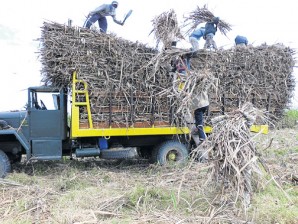‘The hacienda is no more’

SWEET AND SOUR The landmark decision of the Supreme Court ordering the distribution of the land is sweet victory to Hacienda Luisita workers. For the Cojuangcos, it spells the end of the family’s control of the vast sugarcane plantation and sugar milling business in Tarlac. Photo shows workers loading sugarcane on a truck on Wednesday. TONETTE OREJAS/INQUIRER CENTRAL LUZON
A spokesperson said Hacienda Luisita Inc. (HLI) would respect the Supreme Court decision calling for the distribution to workers of the estate owned by the family of President Benigno Aquino III that the Inquirer learned on Thursday owed San Miguel Corp. (SMC) P2 billion.
An SMC source said the farmworker-beneficiaries could be saddled with the debt from the nation’s highly diversified conglomerate of which Mr. Aquino’s uncle, Eduardo “Danding” Cojuangco, is chair. Cojuangco was a major contributor to the President’s election campaign last year.
“I’m not saying that they (hacienda owners) are happy. But they respect it. We shall abide it,” said Tony Ligon, HLI spokesperson.
“It’s not an hacienda anymore. It will be owned by individuals,” he said. “They can plant whatever they want.”
The source close to the Cojuangco family said the P2-billion obligation to SMC stemmed from advances given around 2004 to HLI as payment for sugar products that the conglomerate used for its alcoholic beverages. The source declined to be named because he was not HLI’s designated spokesperson.
“But when the workers started their protests and went on strike, the operations of the Hacienda stopped,” said the source, referring to the bloody incident in 2004 that led to legal battles over workers’ claims that a stock option plan in lieu of land distribution in the hacienda did not benefit them.
“What was originally payment for sugar became SMC’s financial assistance to the hacienda,” the source said. The SMC advances were given in three tranches totaling P1.4 billion, the source said.
“Including the running interest since then, that amount [stands at] about P2 billion now,” he added. “SMC helped Luisita during the difficult times.”
Debt to be repaid
The source explained that this HLI obligation would have to be repaid to SMC either by the government or the farmworker-beneficiaries who would receive parcels of land once the sugar plantation was broken up.
The source also pointed out that the Cojuangco family had given most HLI workers free “home lots” on which their homes were built. “This was given to them for free, so they will also have to compensate the family for this,” he said.
Using the martial law-imposed coconut levy, Danding Cojuangco, a crony of the dictator Ferdinand Marcos, arranged the regime’s acquisition of First United Bank from the Cojuangco-Aquino branch of the clan in the 1970s and turned it into United Coconut Planters Bank (UCPB).
At that time, the current President’s father, the assassinated opposition leader Benigno Aquino Jr., was in jail and world sugar prices were at an all-time low.
While running UCPB, Danding Cojuangco acquired a majority stake in SMC, allegedly using coconut levy funds that were supposed to be used for the amelioration of millions of impoverished coconut farmer.
Then valued at P2 billion, the SMC shares were sequestered following the 1986 Edsa People Power Revolution, but the tycoon won control over the holdings following legal victories that lifted the sequestration. The SMC shares are now worth easily around P200 billion.
Ligon said that HLI had been paralyzed since the 2004 strike. Following the Supreme Court ruling, the company no longer has the obligation to resume operations, he said. “There is no obligation to pay wages.”
Decision not final
However, the HLI spokesperson said the court’s decision was not yet final. “There are matters to be clarified,” he said, but stopped short of saying that they would file a motion for reconsideration before the court.
Foremost is the issue of “just compensation” for HLI land, Ligon said.
In its 56-page decision, the high court said that HLI was “entitled to just compensation” for the agricultural land that will be transferred to the Department of Agrarian Reform (DAR) prior to distribution to the farmers.
Valuation will be reckoned from Nov. 21, 1989, the court said, the date the stock option arrangement was reached between HLI and the farmworkers. The court ordered DAR and Land Bank of the Philippines to determine compensation due the hacienda.
Ligon said HLI deserved to get the fair market price for the land that would be given to the farmworkers.
Ligon noted that factors such as the date of the taking, the current market valuation and the value of agricultural land in the surrounding areas should be considered. “We are not the ones who will decide it. It’s the Supreme Court,” he said.
He noted that when SCTEx brought parts of the hacienda in 2001 for the Subic-Clark-Tarlac Expressway, it paid HLI P100 per square meter. Some parts of the hacienda were sold at a higher rate, he said.
Appeal under study
Apart from just compensation, HLI wants to clarify the issue of the beneficiaries.
About 6,200 farmworkers agreed in 1989 to get a third of the shares of stock in HLI in lieu of land. But over the years, the number had ballooned to 10,000 as their relatives joined them to work in the hacienda, Ligon said.
Vigor Mendoza, another HLI lawyer, said the company wanted a “universal” solution to the land reform issue, pointing to a potentially “bigger problem” as the court ruling leaves 4,000 farmers landless, he said. “Will they be left by the wayside?”
HLI would study if it would appeal the ruling. If it leads to more trouble in the plantation, “we will have to tell the court that,” Mendoza said.














